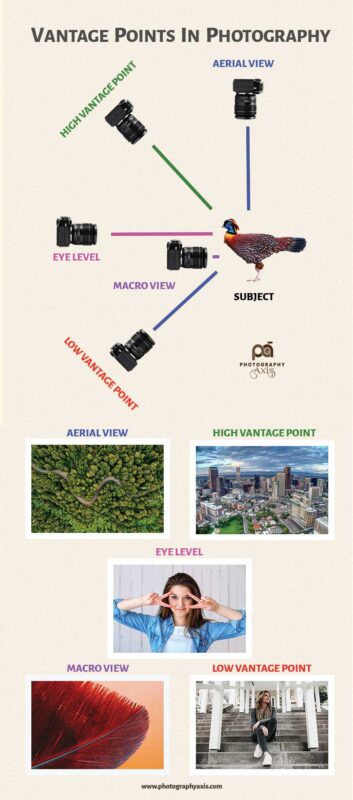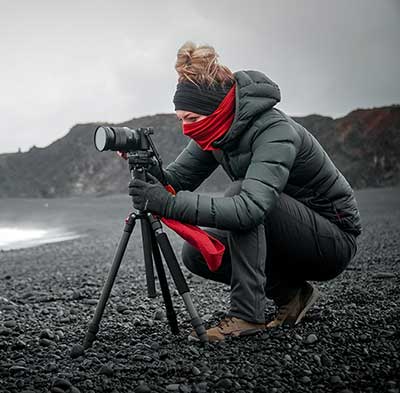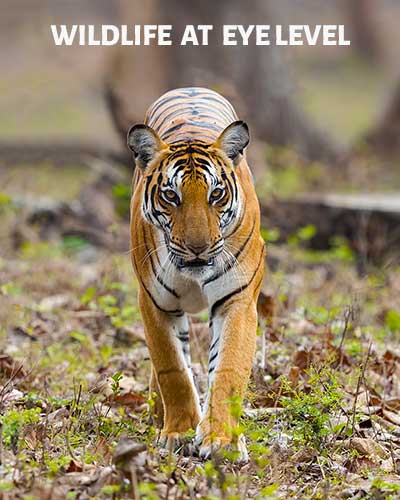Vantage Point in Photography- How to Use +Types+Examples
If you are a newbie in photography, you might be hearing about the vantage point in photography for the first time. As a beginner, it is essential to learn about this aspect of photography and how to use it for your shots.
There are different types of vantage points. The composition of your image will vary when you shoot at different vantage points. So, which is the best vantage point to use for photography? We will find the answers to all these questions in this guide.
What is Vantage Point in Photography?

The position from where you capture an image is the vantage point in photography. In simple words, “It is the angle of image capture.” When you photograph the same scene from different positions, the size and position of various elements in the scene also change. Some elements will look bigger, and others will look smaller when you change the angle of view for the same scene. It will change the mood and feel of the image.
So, you can use it only if you have a clear understanding of the impact of each angle on the image.
Why is Vantage Point Important in Photography? 👩💻
For a photographer, it is all about how you compose the scene and capture it in the camera. The same scene will look different when you photograph it from different angles.
For example, suppose you are going to do forest photography. You are carrying a mirrorless camera with a wide-angle lens and a drone with you. You will be capturing a beautiful pathway with trees on either side using both drone as well as your mirrorless camera.
The image created by these two cameras shooting at two different points of view will be different.

In the drone image, you will see an aerial view of the forest with treetops in the picture. In the case of the image from the mirrorless camera, you will see the forest trees from a different perspective.
You will use different photo composition techniques for both these images. So, the vantage point of an image does have a direct impact on image composition. Thus it is an essential parameter in photography and as a photographer, you need to have a good understanding of this parameter.
It is up to the photographer to decide which vantage point is suitable for a particular scene and shoot accordingly.
What are the Different Types of Vantage Points in Photography?
Now, we will look at the 5 different vantage points in photography.
Eye level Viewpoint

The eye level view helps the viewer connect to the subject in the image. It is a commonly used technique by photographers for capturing portraits. It is suitable for people, animal, and bird portraits.
The main advantage of this shooting angle is you will get the correct perspective of your subject without any distortions. It is also the most common vantage point used by photographers.

Here, your subject will be on the same level as your camera.
Suppose you are shooting the portrait of a person. If you try to shoot it from a lower angle with the camera pointing upwards, then the person will appear large in the frame. However, when you shoot at eye level, you will be able to capture the person in the right proportions.
It does not mean that you need to use this vantage point for all your portrait shots. The angle of view is decided by what you want to show in your image.
Low Vantage point

The low vantage point is useful if you want the subject to dominate in the picture. It will make the subject appear more powerful.
Architecture photographers mainly use this angle. However, it also works for portraits when you want to include more background elements in your portrait. So, it is used only in certain scenarios.

Here, your subject will be at a higher level than your camera.
To create a low vantage point, you need to point your camera upwards. There will be some distortions in the subject shape which is tough to control. Worms eye view is a classic example of low vantage point photography. The worm’s eye view often results in foreshortening.
High Vantage point

There are multiple techniques to create a high vantage point. Here, the shooting angle will be mostly 45 degrees, with the camera pointing downwards.

Here, your subject will be at a lower level than your camera.
If the subject is at your waist level, you can stand and point your camera at the subject and capture the image.
If you want to create a group photo of your friends from this angle of view, you can climb the stair (if you have one nearby) or stand on a chair or desk. Subjects will appear smaller from this angle.
Aerial View

The aerial vantage point is entirely different from the high vantage point. It is the birds eye view of the scene.
There are two ways to capture images from this angle of view. The most popular way is to use drones. The second way is to climb on top of large buildings or mountains and shoot from the top towards the bottom.

Here, you will have the subject on the ground and the camera at the top. The camera will be quite far from the scene and the subject.
Another specialty of aerial view is that 90 percent of such scenes can only be viewed through photos. It is not possible to view such scenes with your naked eyes most of the time.
Close Up/ Macro View

The closeup view is very useful to capture macro images of the subjects with lovely details.
You can use macro lenses to capture closeup shots. It will help provide the necessary magnification to the tiny details in the subject. The level of magnification will depend on the macro lens.

Here, the camera will be very close to the subject and pointing towards it. You can use a tripod for such shots to avoid any shake.
Photographers who capture subjects like flowers, snakes, frogs, and insects make use of this vantage point for the shots.
Vantage Point Infographic 😎

You can refer to the vantage point infographic above to get a clear-cut idea about the different vantage points.
You can see how the angle of view of the camera changes with a change in vantage point. You can see the subject, which is a Tragopan bird, at different angles with varying camera positions.
The five images in the infographic are some great examples of different vantage points in photography.
In the first image, you can see the aerial view of a lush green forest with a road.
The architectural shot at a high vantage point is the second image. The tall buildings in the scene appear smaller in this picture when shot from this perspective.
If you look at the third image, you can see the lady posing with her fingers on her face. Here, the camera is at the eye level of the subject (lady).
When you get the camera closer to the subject with your macro lens, you will be able to capture the tiny feather details as in the image.
The lady sitting on the steps is photographed from a low angle to make the subject more prominent in the frame.
You can download and keep this infographic as a quick reference guide for your shots.
What are the Different Ways to Change Vantage Point?
You can use different techniques to change your vantage point when you photograph a subject. I will list two popular techniques that you can use as a photographer.
1. Use Tripod/ Monopod

You can use a tripod/ monopod to change the viewpoint of the picture.
When you use a tripod to capture images, it allows you to move the camera in different angles and different heights. The amount of movement possible will depend on the type of tripod head that you use.
You can even get to ground level with the help of a tripod. It is possible with a tripod having highly flexible legs. An adjustable center column will also allow you to position your camera at various angles.
2. Camera Type

There are different types of cameras in the market. You have small cameras like the GoPro and the bigger ones like the DSLR, Mirrorless, and Medium Format cameras.
The small GoPro camera will allow you to place the camera in places that are not possible with a regular camera. You need to use the appropriate camera mount to get different vantage points.
You can also go for a drone camera to switch to an aerial view.
Vantage Point Vs Type of Photography
Out of the 5 vantage points, different photography genres prefer different angles of view. So, we will have a look at the popular vantage points in different types of photography.
Wildlife Photography

When it comes to photographing wildlife, eye level view is the most preferred photography angle for photographers. This view helps capture the subject’s body in the right proportions without any distortions.
When you capture portraits of wild animals or birds, you want an excellent blurry background without distractions. The eye level view helps to capture such portraits.
Another angle used by wildlife photographers is the low-level view. It is mainly used in the camera trap shots. The aerial view is also used when using drones for wildlife photography.
Wildlife photographers will go for the macro view if the subject is a frog, snake, insect, etc.
Portrait Photography

When you capture people portraits, you want to have a clear focus on the subject’s eye. It is the eye that connects the viewer to the image. So, the best vantage point for a portrait is the eye level shot. It helps to capture the picture with good details in the eye.
Low-level shots are also used at times. In such photos, the photographers will use a 45-degree angle for the capture most of the time.
Landscape Photography

If you take the case of landscape photographers, they will be mainly using either the low vantage point angle or the high vantage point angle.
A landscape photographer selects a high viewing angle when they want to include more details of the foreground and the middle ground in the final image.
If the sky or the background scene is more important, the photographer will go for the low vantage point shot.
Commercial Photography

These photographers will either use the eye level view or a high angle view for their shots.
If the subject is a man/ woman, eye level view is the most preferred angle. If it is a product shoot, it can be either a high vantage point shot or an eye level one.
Sometimes, the photographer will be going for a flat lay photography style. In that case, he will go with the top view shots.
Vantage Point Vs Focal Length
The focal length of your camera lens does have an impact on the vantage point. So, when you change the focal length of your shoot at different viewpoints, it will affect your image also.
For example, you are photographing a wild animal at the same vantage point, say at eye level—capture one image using a wide-angle focal length and another using a telephoto focal length.
When you compare these two images, you can see that the background is nicely blurred at the telephoto focal length. So, your wildlife subject will stand out from the image.
If you see the wide-angle image, you can see more background is in focus in the image. Thus, you were able to create a picture of the wild animal with its habitat.
So, both of these images are good. But they give a completely different feel to the viewer due to the change in focal lengths.
Next time when you are photographing any scene, try to use different focal lengths to see the effect.

